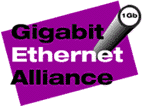10/100/1000 Gigabit Ethernet MegaCamera Interface
Now you can capture high-speed MegaCamera images to your PC from distance of a 100-meters using CAT-5 wire using the Silicon Imaging GigE-CameraLink Interface. The GigE-Cameralink captures MegaCamera digital images and transmits them via 10/100/1000 Gigabit Ethernet directly to your PC at speeds over 100MB/sec.
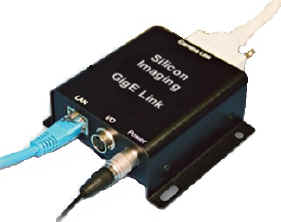
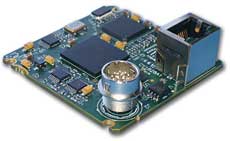
Features:
- Deterministic, continuous data transfer at 1 Gb/s
- Low, predictable end-to-end latency (delay) of less than 500 microseconds
- Advanced, FPGA-based protocol engine
- Built-in GPIO port and control software for advanced real-time triggering
- Camera-to-PC cable separations of 100 meters, further with GigE switches
- Low-cost Category 5 copper LAN cabling
- Commercial GigE platform with no frame grabber
- Flexible, scaleable GigE networking options
- Easy to implement and use
- IP Driver streams data to PC memory with only 1% CPU load
- SDK for fast integration with third-party or custom vision applications
- 3rd Party Vision Package Support:
|
IO Industries |
Video Savant |
| Matrox | MIL |
| Media Cybernetics | Image Pro |
| Microsoft | DirectShow |
| MVTec | Halcon |
| National Instruments | Labview |
| NorPix | StreamPix |
Silicon Imaging GigE-CameraLink connectivity products deliver unique value to a wide range of vision applications, including industrial inspection and control, medical imaging, intelligent traffic monitoring, enterprise surveillance, digital cinema, and remote healthcare.

In all applications, Silicon Imaging GigE-Cameras reduce complexity, lower costs, and improve system efficiencies by allowing camera manufacturers and systems integrators to create long-reach, high-performance IP/Ethernet links between cameras and PCs.
Until now, to meet speed, throughput, and processing requirements, most high-performance cameras have been point-to-point connected to local PCs using specialized protocols and interface equipment. These point-to-point links typically extend only a few meters, which means host PCs are essentially tethered to cameras. And, to receive and process images, the PCs must be fitted with costly frame grabber boards.
Silicon Imaging GigE-CameraLink removes the distance limitations and eliminate the need for a frame grabber. With GigE-CameraLink MegaCameras you send the image data directly to PC memory over Gigabit Ethernet connections, at rates of up to 100 MB/s. Each MegaCamera is defined and supported as a distinct IP network device. These high-speed camera-to-PC links operate reliably over 100 meters of standard, inexpensive Cat-5 LAN cable. And by using low-cost Gigabit Ethernet switches, you can extend the reach much further.
The superior reach of GigE-CameraLink allows PCs to migrate from operations areas into designated computer centers, enabling a few centralized servers to replace large numbers of costly, industrial-grade PCs.
Moreover, Silicon Imaging GigE-LinkTM solutions support a flexible range of image processing options and network topologies, including:
- traditional, point-to-point links between one camera and one PC;
- connections from one camera to multiple PCs;
- connections between multiple cameras and one PC; and
- connections between multiple cameras and multiple PCs.
Point-to-point links between one camera and one PC

This configuration offers a fast, easy way to extend distance between cameras and PCs. The GigE-CameraLink and the PC are connected by ordinary, low-cost Cat-5 LAN cable. The links extend up to 100 meters, and are fully bi-directional. The GigE-CameraLink converts image data into Ethernet packets for transport to the PC, and control signals (RS-232 or GPIO) are passed back to the camera.
For demanding applications, the GigE-CameraLink High-Performance IP Driver or GigE-CameraLink Universal IP Filter Driver allow users to send data directly to PC memory. The drivers bypasses the compute-intensive Windows stack, using instead an ultra-efficient processing stack that is optimized for delivering image data. This powerful technique minimizes end-to-end latency and maximizes data rates. The GigE-CameraLink High-Performance IP Driver uses only about 1% of the CPU's processing power, leaving almost all its capacity free for running applications.
Connections from one camera to multiple PCs

This configuration is suitable for applications like medical x-ray imaging or OCR (optical character recognition), where image data from one source needs to be "multicast," or simultaneously distributed, to multiple PCs or other destinations.
The figure above shows a medical x-ray imaging application with the multicast option. Since x-rays are used, and emissions are a safety concern, links of about 30 meters are desired, which are easily supported by GigE-CameraLink. The Gigabit Ethernet link from the camera terminates in a four-port Ethernet switch. The three Gigabit Ethernet outputs terminate at three separate PCs, one to display the image, one to process it, and one to archive it. All Gigabit Ethernet links are bi-directional, including those between the PCs. Inter-PC control is handled via one of the PCs.
The figure below illustrates another example of multicasting, where GigE-CameraLink is used to process an OCR application, such as identifying hand-written addresses on mail pieces. The image of the address is captured by one camera and sent simultaneously to three PCs. The PCs are configured as a processing "cell," with each computer optimized to process a different style of handwriting. The application selects the best of the three processing results to direct the mail piece to the appropriate bin. This approach offers an economical, scalable alternative to boosting the power of one PC with DSP (digital signal processing) or FPGA (field programmable gate array)-based add-on cards.
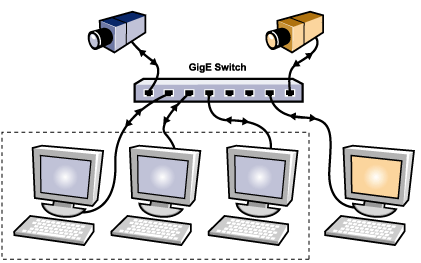
The fourth PC is used as a controller, and to process other information on mail pieces, such as bar codes, which do not require as much processing power.
Connections between multiple cameras and one PC
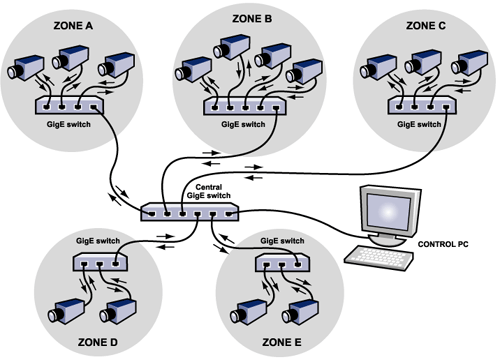
This configuration is useful in applications like surveillance, where coverage areas are divided into zones, with multiple cameras in each zone. A single PC controls and receives image data streams from all zones, and all links are bi-directional. Each GigE-Camera terminates at a Gigabit Ethernet switch, with one switch per zone.
The zone switches terminate at a final switch with a single link to a central command PC. The PC activates the zones, as well as the cameras in each zone, in cycles defined by the application and data rate. For example, images can be sequentially acquired from each camera (cameras share a common sync) in a repetitive cycle until triggered to stop. Local display PCs can also be connected to zones, if desired, as in Zone D.
Using the dynamic bandwidth allocation features of the GigE-CameraLink, a motion detector connection to an GigE-CameraLink can trigger a "gear up" or "gear down" of acquisition rates in specific zones, when required. In this way, a camera never sends out more image data than required by the control application, resulting in very effective use of network bandwidth.
Connections between multiple cameras and multiple PCs
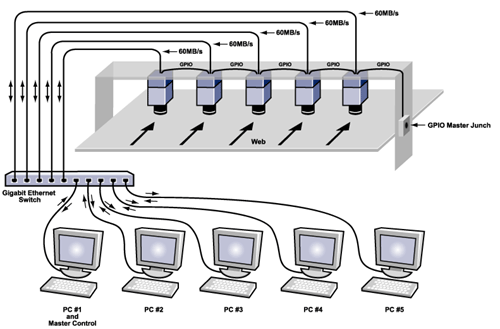
This configuration is suitable for applications such as web inspection in a rolling steel mill or newsprint manufacturing facility, where multiple line-scan cameras are installed across the width of the web to provide end-to-end vision coverage.
Each camera is connected to an GigE-CameraLink. The cameras are synchronized via the network to allow continuous data capture linked to the speed of the web. For the image processing to keep up with the web, the cameras operate at about 60 MB/s (i.e. 60K lines per second of 1K pixels each).
The data processing function is shared among multiple PCs synchronized via the network. Each camera can be mapped to one or more front-line processing PCs and one control PC. The control PC performs a final analysis of the results generated by the front line processing PCs, and controls the complete web process, including I/O control, via RS-232 or independent remote GPIO, of the cameras and processing PCs.
